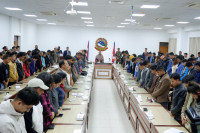Opinion
Food quest
Strengthening of local food systems would give people greater choices while making decisions about migration
Jagannath Adhikari & Ramesh Sunam
Achieving food security has become a critical development issue worldwide. It is more so for Nepal, as it is facing serious social, political and economic problems. The issue has become a concern for the households, the nation, and development agencies. However, the dilemma is that they are taking a rather divergent approach to deal with it.
Globally, progress in food security is rather slow and contentious. A variety of contextual factors—low food production, inequitable distribution of arable land resources, rapid increase in food prices and fluctuations in food availability, greater reliance on energy-dense, meat-based diets and imported food, and increased vulnerability of food production systems—have exacerbated food insecurity. For example, The State of Food Insecurity in the World 2015, a report of Food and Agricultural Organisation of the United Nations, shows that 794.6 million people in the world are chronically malnourished; most of them (779.9 million) live in developing regions.
The past two decades have witnessed significant improvements in overcoming hunger and malnutrition, but South Asia, where food insecurity and malnutrition are concentrated, has seen limited progress. Poor households, children and women are the ones who suffer most from food shortages and malnutrition. Malnutrition rate among children is still very high. Nepal continues to face a high level of food and nutritional insecurity even though there has been some progress in a few nutrition indicators. There has been a rapid decline in the poverty level in the past 20 years in Nepal (from 42 percent in 1995-96 to 25 percent in 2010-11), but this has not translated into nutritional and food security outcomes, and there are recurrent food crises.
No choice but to migrate
There are three main pathways that households could follow to improve their food security: (1) increase household food production and gain income from local livelihood opportunities; (2) migrate and send remittances to buy food; (3) rely on society or government’s social security mechanisms. Many Nepali households have taken the second path.
Given that most households have a small landholding and that there is limited social and government support to produce food, farming as a pathway to food security is becoming inadequate and less attractive in the country. As a result, households have preferred to send members, especially males, to foreign countries to earn. Local food production and rural enterprises are slowly moving out from the state’s priority. All these have led to a decline in food production, fallowing of land in the middle hills and the Himalayan region and conversion of arable land into real-estate housing plots, mostly in the Tarai and places near major highways.
The import of cheap rice has partly caused a decline in food production, as imported rice is often cheaper because of subsidies given by the government where it is produced. Food production is costlier in Nepal than in other countries in South Asia. The third option is also not significant for households in Nepal, as the government does not have a strong social security policy and adequate resources. Apart from a small amount of subsidised food distribution and some food-for-work programmes, there is no significant social security arrangements. To have a robust social security programme, a country needs to have a firm political commitment and a strong economy. Nepal has neither. Therefore, people have no choice but to migrate.
The problem with government policies as well as those of development partners is that they treat the three pathways as separate and distinct, assuming that one would negatively impact others. Consequently, the second pathway (migration) has improved short-term food security in Nepal but has eroded the first pathway—ensuring food sovereignty of the country and households. Our recent studies in both the middle hills and the Tarai clearly reveal this emerging tendency. The international trade blockade, global increase in food prices and difficulties in importing food have led to food shortages in the country. Without a course correction, such instances will recur, potentially causing food riots and other social problems.
Reorientation in policy
Policies and practices need to bring the three pathways to food security together for facilitating better livelihoods outcomes. The strengthening of local food systems would give people greater choices while availing themselves of migration opportunities. The migration pathway could generate much-needed investment for local agro-ecology and enterprises.
But at present, lack of an appropriate investment environment for local agro-enterprises and resource conservation has eroded the capacity to produce food and income locally. This has led to further abandoning of farmlands and importation of food grain (mainly rice) and packaged food with serious implications on nutritional security. Social remittance such as skills learned overseas could help start new enterprises to produce goods and commodities, but at present these skills are not capitalised on. A few examples of successful enterprises have been found, but there are various barriers to expansion. Whatever is seen has been the result of a few enterprising individuals who struggled against various odds in the policy environment and social norms.
In sum, policies and institutional set-up in Nepal have been unnecessarily sectoral. Nepali society and economy have restructured and changed rapidly. But policy-makers and institutional set-up have remained more or less stagnant. This has been unhelpful. A reorientation in policy that integrates the three pathways would be beneficial for sustainable food security in Nepal.
Adhikari is a human geographer with an interest in development planning; Sunam is a research associate at Australian National University




 15.12°C Kathmandu
15.12°C Kathmandu











